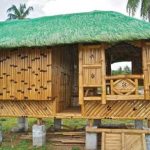
In the last issue, I wrote about sugarcane bagasse, sisal, cactus, cotton and bamboo as very useful species in building construction. In the next issues, I will be discussing the physical, chemical and mechanical properties of each plant that make it good construction material. After all have been exhaustively discussed, I will tackle other species that were not mentioned earlier like papyrus but are being used as construction materials. For now, let us appreciate the physical, chemical and mechanical properties of bamboo that make it a good construction material.
Bamboo is a plant belonging to the true grass family Poaceae, subfamily Bambusoideae, tribe Bambuseae. In bamboo, the internodal regions of the stem are hollow and the vascular bundles in the cross-section are scattered throughout the stem instead of a cylindrical arrangement as is the case in the trees. In building construction, bamboo provides pillars, floors, walls, doors, window frames, rafters, room separators, ceilings and roofs. Bamboo is also used to make pegs which replace nails. Bamboo scaffolding finds extensive use even on very tall buildings.
Physical properties of bamboo are the quantitative characteristics of bamboo and its behaviour to external influences other than applied forces, while the mechanical properties of bamboo are an expression of its behaviour under applied forces. This behaviour can be modified in a number of ways. Chemical properties of bamboo deal with its composition or the characteristics of bamboo that are observed during a reaction in which the chemical composition is changed.
Physical properties
Physical properties of bamboo vary greatly from species to species, and to some extent within a species. Culms are generally long and straight and the hollow internodes make it comparatively light. The strength of bamboo varies within the species, age of culm, moisture content and portion of culm and generally increases until it reaches maturity.
The tensile strength of bamboo pole is high parallel to the grain. Bamboo possesses very high moisture content. Green bamboo may have 100% percent moisture (oven-dry weight basis) and can be as high as 155 percent for the innermost layers to 70 percent for the peripheral layers. The vertical variation from the top (82%) to the bottom (110%) is comparatively less. The specific gravity of bamboo varies between 0.4 and 0.8 depending mainly on the anatomical structure. The fibre saturation point of bamboo is around 20-22
Bamboo can be glued very well. It is also highly flexible and can sustain substantial tension. Unlike wood, bamboo has no secondary growth. Wettability of bamboo has a significant influence on adhesion and other related properties. In terms of adhesion theory, bond formation involves wetting, adsorption, and inter-diffusion of the resin with respect to the adhered substrate.
Chemical properties
The composition of bamboo varies based on years of growth, season, species and the part of the culm. The main constituents of bamboo culms are cellulose, hemi-cellulose and lignin, which amount to over 90% of the total mass. The minor constituents of bamboo are resins, tannins, waxes and inorganic salts. Compared with wood, bamboo has higher alkaline extractives, ash and silica content. High silica content of the outer layer resists animal, chemical, mechanical damages.
Bamboo contains about 2-6% starch, 2% deoxidized saccharide, 2-4% fat, and 0.8-6% protein. The carbohydrate content of bamboo plays an important role in its durability and service life. The natural durability of bamboo varies between 1 and 36 months depending on the species and climatic condition. Nonetheless, the presence of large amounts of starch makes bamboo highly susceptible to attack by staining fungi and powder-post beetles. It is noteworthy that even in 12-year-old culms starch is present in the whole culm, especially if the culms were in the longitudinal cells of the ground parenchyma.
The ash content of bamboo is made up of inorganic minerals, primarily silica, calcium, potassium, manganese and magnesium. Silica is the highest in the epidermis, with very little in the nodes and is absent in the internodes. Higher ash content in some bamboo species can adversely affect the processing machinery. The culm of bamboo is covered by its hard epidermis and inner wax layer. It lacks ray cells as radial pathways. Several results have revealed that bamboo is difficult to treat with preservatives.
Mechanical properties
The fibres of bamboo contribute 60-70% of the weight of the total culm tissue. They are long, tapered at their ends and concentrate in the regions closer to the outer skin. The ratio of length to width varies between 150:1 and 250:1. This is consistent with the stress distribution when the culm is subjected to wind forces. Bamboo fibres are often known as natural glass fibre due to the high strength its weight derives from fibres longitudinally aligned in its body. The density of the fibres in the cross-section of a bamboo shell varies along its thickness. This presents a functionally gradient material, evolved according to the state of stress distribution in its environment. The fibres have weak transverse bonds and can thus split easily along the length (radial/tangential).
The tensile strength of bamboo is relatively high and can reach 370 MPa. This makes bamboo an attractive alternative to steel in tensile loading application. Bamboo has high stress at proportional limit and a high modulus of elasticity. The modulus of elasticity of bamboo is higher than that of hardwood, but it is easy to break when applied with high load. Bamboo fails in shear before it fails in tension and therefore the modulus of rapture is used to calculate its strength.
Bamboo’s environmental benefits arise largely out of its ability to grow and spread quickly, in some cases three to four feet per day without the need for fertilizers, pesticides or much water. Bamboo is so fast-growing that it can yield 20 times more timber than trees on the same area.
A bamboo grove also releases some 35 percent more oxygen into the air than a similar-sized stand of trees. Because of this, planting bamboo is a great way to reduce your carbon footprint and help fight global warming, a perfect selection for going green as it matures (and can be replanted) within seven years (compared to 30-50 years for a stand of trees). Furthermore, it helps to improve soil conditions and prevent erosion along the way.
Bamboo can replace a variety of woods that are being increasingly used for construction today, and thus help in saving forests which today are in a critical stage of deforestation.
Therefore, bamboo should be the material of choice in building construction.
